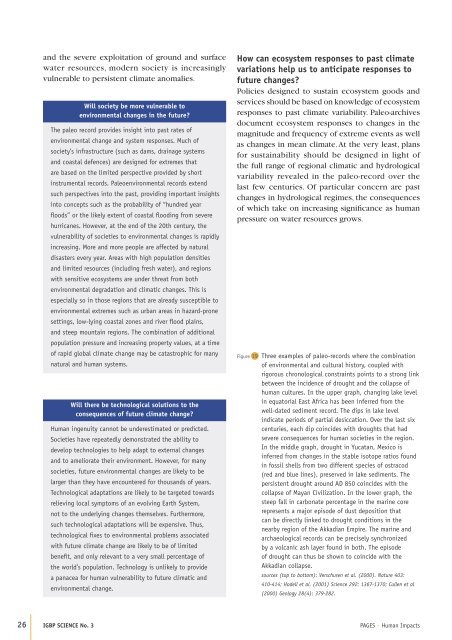Environmental Variability and Climate Change
Environmental Variability and Climate Change
Environmental Variability and Climate Change
You also want an ePaper? Increase the reach of your titles
YUMPU automatically turns print PDFs into web optimized ePapers that Google loves.
<strong>and</strong> the severe exploitation of ground <strong>and</strong> surface<br />
water resources, modern society is increasingly<br />
vulnerable to persistent climate anomalies.<br />
Will society be more vulnerable to<br />
environmental changes in the future?<br />
The paleo record provides insight into past rates of<br />
environmental change <strong>and</strong> system responses. Much of<br />
society’s infrastructure (such as dams, drainage systems<br />
<strong>and</strong> coastal defences) are designed for extremes that<br />
are based on the limited perspective provided by short<br />
instrumental records. Paleoenvironmental records extend<br />
such perspectives into the past, providing important insights<br />
into concepts such as the probability of “hundred year<br />
fl oods” or the likely extent of coastal fl ooding from severe<br />
hurricanes. However, at the end of the 20th century, the<br />
vulnerability of societies to environmental changes is rapidly<br />
increasing. More <strong>and</strong> more people are affected by natural<br />
disasters every year. Areas with high population densities<br />
<strong>and</strong> limited resources (including fresh water), <strong>and</strong> regions<br />
with sensitive ecosystems are under threat from both<br />
environmental degradation <strong>and</strong> climatic changes. This is<br />
especially so in those regions that are already susceptible to<br />
environmental extremes such as urban areas in hazard-prone<br />
settings, low-lying coastal zones <strong>and</strong> river fl ood plains,<br />
<strong>and</strong> steep mountain regions. The combination of additional<br />
population pressure <strong>and</strong> increasing property values, at a time<br />
of rapid global climate change may be catastrophic for many<br />
natural <strong>and</strong> human systems.<br />
Will there be technological solutions to the<br />
consequences of future climate change?<br />
Human ingenuity cannot be underestimated or predicted.<br />
Societies have repeatedly demonstrated the ability to<br />
develop technologies to help adapt to external changes<br />
<strong>and</strong> to ameliorate their environment. However, for many<br />
societies, future environmental changes are likely to be<br />
larger than they have encountered for thous<strong>and</strong>s of years.<br />
Technological adaptations are likely to be targeted towards<br />
relieving local symptoms of an evolving Earth System,<br />
not to the underlying changes themselves. Furthermore,<br />
such technological adaptations will be expensive. Thus,<br />
technological fi xes to environmental problems associated<br />
with future climate change are likely to be of limited<br />
benefi t, <strong>and</strong> only relevant to a very small percentage of<br />
the world’s population. Technology is unlikely to provide<br />
a panacea for human vulnerability to future climatic <strong>and</strong><br />
environmental change.<br />
How can ecosystem responses to past climate<br />
variations help us to anticipate responses to<br />
future changes?<br />
Policies designed to sustain ecosystem goods <strong>and</strong><br />
services should be based on knowledge of ecosystem<br />
responses to past climate variability. Paleo-archives<br />
document ecosystem responses to changes in the<br />
magnitude <strong>and</strong> frequency of extreme events as well<br />
as changes in mean climate. At the very least, plans<br />
for sustainability should be designed in light of<br />
the full range of regional climatic <strong>and</strong> hydrological<br />
variability revealed in the paleo-record over the<br />
last few centuries. Of particular concern are past<br />
changes in hydrological regimes, the consequences<br />
of which take on increasing signifi cance as human<br />
pressure on water resources grows.<br />
Figure 19<br />
Three examples of paleo-records where the combination<br />
of environmental <strong>and</strong> cultural history, coupled with<br />
rigorous chronological constraints points to a strong link<br />
between the incidence of drought <strong>and</strong> the collapse of<br />
human cultures. In the upper graph, changing lake level<br />
in equatorial East Africa has been inferred from the<br />
well-dated sediment record. The dips in lake level<br />
indicate periods of partial desiccation. Over the last six<br />
centuries, each dip coincides with droughts that had<br />
severe consequences for human societies in the region.<br />
In the middle graph, drought in Yucatan, Mexico is<br />
inferred from changes in the stable isotope ratios found<br />
in fossil shells from two different species of ostracod<br />
(red <strong>and</strong> blue lines), preserved in lake sediments. The<br />
persistent drought around AD 850 coincides with the<br />
collapse of Mayan Civilization. In the lower graph, the<br />
steep fall in carbonate percentage in the marine core<br />
represents a major episode of dust deposition that<br />
can be directly linked to drought conditions in the<br />
nearby region of the Akkadian Empire. The marine <strong>and</strong><br />
archaeological records can be precisely synchronized<br />
by a volcanic ash layer found in both. The episode<br />
of drought can thus be shown to coincide with the<br />
Akkadian collapse.<br />
sources (top to bottom): Verschuren et al. (2000). Nature 403:<br />
410-414; Hodell et al. (2001) Science 292: 1367-1370; Cullen et al<br />
(2000) Geology 28(4): 379-282.<br />
26 IGBP SCIENCE No. 3 PAGES – Human Impacts

















